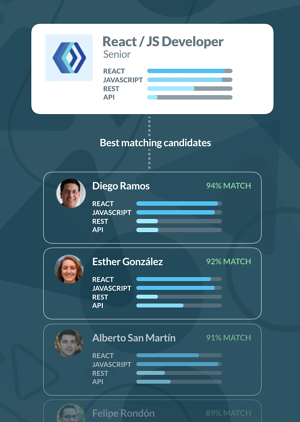Something that makes Get on Board unique is its ability to match jobs and professionals based on their descriptions and CVs and their past interaction and success.
Our algorithms (yes, we have more than one) detect and weigh hundreds of different signals from activity in our platform— for instance, candidates hired or discarded for different reasons across several hiring processes by thousands of companies—in order to determine the relevance of jobs and professionals in relation to a carefully selected list of tags (describing technologies, tools, and skills).
This allows us to build a "heat map" of each candidate, where some technologies and skills are more related to a specific candidate than others. This profile is then filtered by additional parameters (such as job location, salary, and experience level) to match a particular job.

This is where a second algorithm reorders applicants, rewarding candidates that have a better history in Get on Board. This history compares results in a job process with other candidates in similar processes, establishing a relative ranking that determines who appear first in the results list.
These algorithms are put to work every time Boost is activated in a job—to automatically determine who are the most relevant professionals—, and in the Talent Database search results, where a recruiter can perform custom candidate searches.